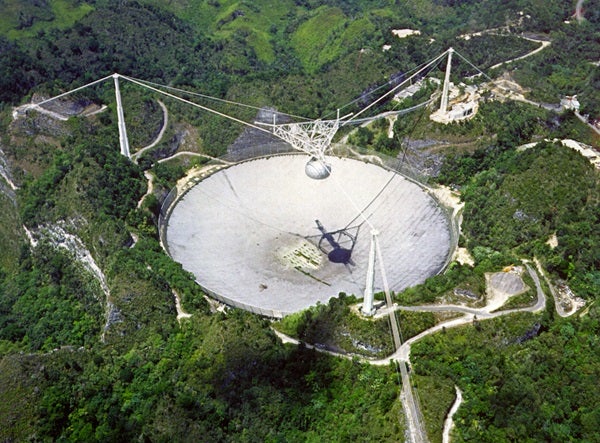The 54-year-old observatory has weathered a lot of storms over the years — ranging from tropical to financial. And last week, it made it through yet another as The National Science Foundation (NSF) signed a Record of Decision for Arecibo Observatory, which outlines a plan to fund the facility over the next half decade, albeit at a much-reduced rate.
Currently, the NSF funds about two-thirds of Arecibo’s annual operating budget of $12 million. However, with this new decision, the NSF’s annual contribution will be reduced from $8.2 million to just $2 million over the next five years. Though it is still unclear where the remaining funding will come from, the plan is to rely on unspecified partner institutions to foot the rest of the bill.
Measuring 1,000 feet (305 m) across, Arecibo held the record for the world’s largest single-dish radio telescope until China recently began operating the 500-meter FAST radio telescope. Built into the limestone hills of western Puerto Rico, Arecibo is a secluded gem for the scientific community. Over the course of the last half-century, Arecibo has used radio waves to study things ranging from Earth’s atmosphere to deep-space objects.
- 1967 – Arecibo discovers Mercury rotates once every 59 days, much less than the previously estimated value of 88 days.
- 1974 – Arecibo discovers the first binary pulsar, ultimately leading to a Nobel Prize in Physics.
- 1981 – Arecibo creates the first radar maps of the surface of Venus, revealing what lies beneath the planet’s optically opaque atmosphere.
- 1989 – Arecibo captures the first direct image of an asteroid, 4769 Castalia, and produces a three-dimensional model of the object.
- 1992 – Arecibo discovers the first exoplanet ever around the pulsar PSR 1257+12, igniting the field of exoplanetary research.
- 2008 – Arecibo detects the complex compounds methanimine and hydrogen cyanide in the distant starburst galaxy Arp 220.
- 2016 – Arecibo discovered the first repeating fast radio burst (FRB), ruling out the theory that all FRBs require catastrophic explosions.
Despite all of the great discoveries Arecibo Observatory has made over the years, the utility of the dish has waned in the past decade, largely explaining the NSF’s divestment strategy. In addition to shrinking the budget for Arecibo, the NSF is also considering reducing funds for the Green Bank Observatory in West Virginia, as well as several other observatories.
Though the NSF is committed to decreasing the amount of money it spends on aging astronomical research facilities, it still plans to reinvest these funds into future projects, such as the Large Synoptic Survey Telescope that is currently being constructed in Chile.
Despite the reduction in overall funding, Arecibo Observatory’s director, Francisco Córdova, said in a press release, “This is very good news for the Arecibo Observatory and a huge win for the scientific community in general.”










